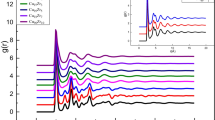Abstract
By a mean field theoretical computation, the equilibrium distributions of additional Ag and Al in the crystalline phase of CuZr-based alloys were determined to occupy the two sublattices of the B2 structure randomly. With the molecular dynamics technique, the effects of Ag and Al on the enthalpy difference (ΔH) between the supercooled melt and the crystalline phase were evaluated. The improved glass forming ability of Cu45Zr45Al10 and Cu45Zr45Ag10 can be attributed to their remarkably smaller ΔH than that of CuZr. The calculated diffusion coefficients are more sensitive to the atomic weight of the component atoms than to their interaction strength. As the component atom with the largest mass, the additional Ag increases the viscosity of the supercooled melt significantly and the experimentally stronger glass formation ability of Cu45Zr45Ag10 than Cu45Zr45Al10 can be well understood.
Similar content being viewed by others
References
A. Inoue, High strength bulk amorphous alloys with low critical cooling rates (overview), Mater. Trans. JIM, 36(1995), No.7, p.866.
A. Inoue, T. Zhang, and A. Takeuchi, Bulk amorphous alloys with high mechanical strength and good soft magnetic properties in Fe-TM-B (TM=IV-VIII group transition metal) system, Appl. Phys. Lett., 71(1997), No.4, p.464.
Z.P. Lu, C.T. Liu, J.R. Thompson, et al., Structural amorphous steels, Phys. Rev. Lett., 92(2004), No.24, p.245503–1.
X.H. Lin and W.L. Johnson, Formation of Ti-Zr-Cu-Ni bulk metallic glasses, J. Appl. Phys., 78(1995), No.11, p.6514.
A. Inoue, W. Zhang, T. Zhang, et al., High-strength Cu-based bulk glassy alloys in Cu-Zr-Ti and Cu-Hf-Ti ternary systems, Acta Mater., 49(2001), No.14, p.2645.
A. Takeuchi and A. Inoue, Classification of bulk metallic glasses by atomic size difference, heat of mixing and period of constituent elements and its application to characterization of the main alloying element (overview), Mater. Trans. JIM, 46(2005), No.12, p.2817.
P. Yu, H.Y. Bai, M.B. Tang, et al., Excellent glass-forming ability in simple Cu50Zr50-based alloys, J. Non Cryst. Solids, 351(2005), No.14-15, p.1328.
A. Inoue and W. Zhang, Formation, thermal stability and mechanical properties of Cu-Zr-Al bulk glassy alloys, Mater. Trans. JIM, 43(2002), No.11, p.2921.
W. Zhang and A. Inoue, High glass-forming ability and good mechanical properties of new bulk glassy alloys in Cu-Zr-Ag ternary system, J. Mater. Res., 21(2006), No.1, p.234.
K. Yamaguchi, Y.C. Song, T. Yoshida, et al., Thermodynamic investigation of the Cu-Zr system, J. Alloys Compd., 452(2008), No.1, p.73.
X.D. Ni, N.X. Chen, J. Shen, et al., Generalized model for atomic site preference in crystal and its application in rare-earth alloys, Intermetallics, 17(2009), No.1–2, p.1.
N.X. Chen and G.B. Ren, Carlsson-Gelatt-Ehrenreich technique and the Möbius inversion theorem, Phys. Rev. B, 45(1992), No.14, p.8177.
W.Q. Zhang, Q. Xie, X.J. Ge, et al., Interatomic potentials between distinct atoms from first-principles calculation and lattice-inversion method, J. Appl. Phys., 82(1997), No.2, p.578.
F.F. Chen, H.F. Zhang, F.X. Qin, et al., Molecular dynamics study of atomic transport properties in rapidly cooling liquid copper, J. Chem. Phys., 120(2004), No.4, p.1826.
F. Guo, S.J. Poon, and G.J. Shiflet, Metallic glass ingots based on yttrium, Appl. Phys. Lett., 83(2003), No.13, p.2575.
W. Qin, J. Li, H. Kou, et al., Effects of alloy addition on the improvement of glass forming ability and plasticity of Mg-Cu-Tb bulk metallic glass, Intermetallics, 17(2009), No.4, p.253.
J.W. Christian, The Theory of Transformations in Metals and Alloys, Pergamon, London, 1965, p.399.
O. Suárez-Iglesias, I. Medina, C. Pizarro, et al., On predicting self-diffusion coefficients from viscosity in gases and liquids, Chem. Eng. Sci., 62(2007), No.23, p.6499.
H. Togrul and N. Arslan, Flow properties of sugar beet pulp cellulose and intrinsic viscosity-molecular weight relationship, Carbohydr. Polym., 54(2003), No.1, p.63.
Author information
Authors and Affiliations
Corresponding author
Rights and permissions
About this article
Cite this article
Ni, Xd., Wang, Z., Sun, X. et al. Mechanism of Ag and Al on improving the glass forming ability of CuZr-based alloys. Int J Miner Metall Mater 18, 424–429 (2011). https://doi.org/10.1007/s12613-011-0457-2
Received:
Revised:
Accepted:
Published:
Issue Date:
DOI: https://doi.org/10.1007/s12613-011-0457-2




